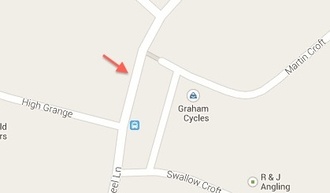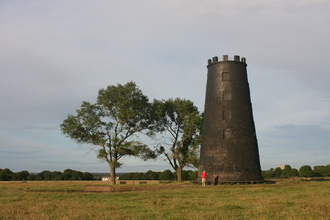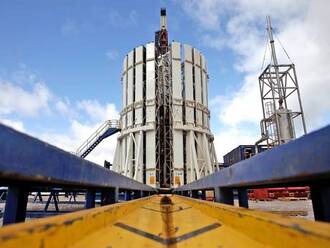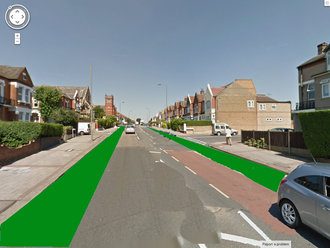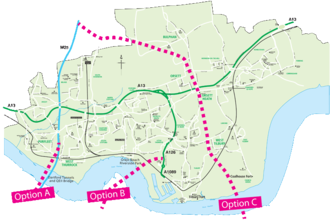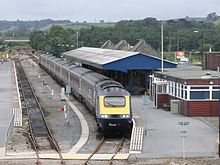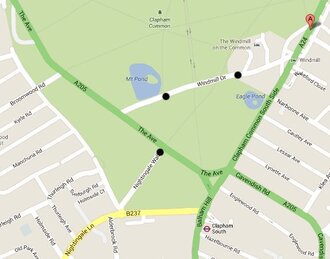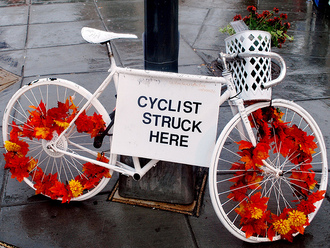-
Reopen Poulton-Fleetwood/Open A New Fleetwood-Lancaster Railway Line/A New Garstang Train StationIf the population increases and grows, it would be ideal to make the possible train service to those who want it back, that's if the people petition to have the old lines reopened, SELRAP have also done their part too for the Colne-Skipton rail line.116 of 200 SignaturesCreated by Johnathan Riley
-
Proposal for crossing person/pedestrian crossing on Wheel Lane, LichfieldWe feel this is an important step to ensure optimum safety while crossing what can be a busy road. It is en route to shops and schools, and more recently a Post Office. From personal experience it can be a tricky road to cross at school run times and I believe having a crossing would make it significantly safer and easier to cross, particularly for children who are able to walk to school by themselves. Although it is a 20mph road, I have seen many motorists exceeding the limit and think a crossing would help slow traffic down. I have spoken to a few parents who agree it would work well. My husband tells me there used to be a crossing lady at this point when he was a child. A pedestrian crossing was installed on Beacon Street where the Post Office used to be so I think a crossing on Wheel Lane would be well used by customers of the Post Office and shops also.158 of 200 SignaturesCreated by Mia Webb
-
Save Our WestwoodThis is not a scare story: Beverley's beloved common, Westwood, is under threat. There is a proposal to allow temporary access across a portion of the Westwood to permit the developers easy access to the old Westwood Hospital Site. If this were to happen this would set a precedent that could then be used by other developers to access other potential development sites adjacent to the Westwood, such as the Grammar School, Minster School, Archery Field, East Riding College, Longcroft Lower School, Longcroft Higher School and potentially Grosvenor Place. If any such access is granted, it is unlikely that it will ever be removed completely and damage will be done to the integrity of the Westwood as well as its fauna and flora: trees will be cut down, hedges broken through and grasslands compacted and altered forever. This, over time, will result in the loss, piece by piece, of the Westwood we know: a Westwood we have a duty to pass on to our children in the condition we inherited it. Beverlonians have protected our commons for centuries, are we really going to throw this away for the sake of six or so lorry movements per day over 18 months? If we do, we would be betraying those who fought for these commons in the past. There is a vociferous, ill-informed campaign promoting the idea of access across the Westwood, however, the emotive campaign they are running is full of omissions. The facts of the case are set out below. Town Route: Problems Congestion in the narrow streets; Increased traffic movements on these streets; Increased noise for the residents. Westwood Route: Problems The route of this access road will cross and damage ancient common land; The route will damage the existing grassland; The route will involve the removal of a section of species-rich hedgerow; The route will involve the removal of a small tree; There will be increased traffic movements on the Westwood; The temporary road will set a precedent. Town Route: Mitigation Measures The developers have said they will limit lorry movements to 12 per day during demolition ( c. 2 months); The developers have said they will limit lorry movements to 6 per day during the construction phase, 16 months; The developers will use a small lorry; There will be no lorry movements during the rush hours nor at school pick-up and drop-off times. Westwood Route: Mitigation Measures The developers say they will re-instate the grassland; They will replant the hedge; They will replant the tree. It would appear that the problems associated with the town route can be easily mitigated against and the very small number of lorry movements per day is more than reasonable, especially when you take into consideration the number of movements there used to be when the Westwood Hospital was open and when the new housing estate is built. These movements included ambulances, delivery vehicles, skip lorries, gritting lorries and patients being picked-up and dropped-off. Concern has also been raised regarding the danger to schoolchildren at Minster School. The developers appear to have taken this into account in their plans and will schedule no lorry movements during the rush hour or at school pick-up and drop-off times. In truth the biggest risk to school children is local residents speeding along The Leases or rat-running up Central Avenue and Thurston Road to get to Cartwright Lane. In terms of the access across the Westwood, there appears to very little that the developers can do to mitigate against the damage they will cause. Whilst they have said they will reinstate everything they damage, in ecological terms this is easier said than done and, in most cases, is impossible. Their route will destroy a species-rich hedge which cannot be replaced in our lifetimes. The problem of precedent cannot easily be undone, once the access route has been constructed. This will encourage other developers to do likewise in order to develop other sites, more difficult to access than the old Westwood Hospital site, by insisting on temporary access across the Westwood. This would open-up areas, such as Grosvenor Place and Minster School to development pressure.7,712 of 8,000 SignaturesCreated by Beate Willar
-
20mph speed limit for Preston Drove, Stanford Avenue, and Surrenden Road in BrightonHundreds of pedestrians have to cross these intimidating roads every day, many of them children attending a number of local schools, particularly Balfour Primary, Downs Infant and Junior, Dorothy Stringer, Varndean and The Montessori School. There are also two parks adjacent to the roads (Blaker’s and Preston which are a popular choice for sports, recreation and walking), a busy local shopping area, homes for older people and several children’s nurseries. We urge the city council to prioritise the needs of people for safer roads where they live, shop, work, play and go to school and reduce these traffic speeds as soon as possible. Preston Drove and Stanford Avenue were excluded from the 20mph speed limit scheme on the basis that they are "key bus and taxi routes", but buses only use sections of those roads or are infrequently scheduled, so they are not key routes. Surrenden Road is a wide dual carriageway in a residential area and the traffic presents a clear risk to children and adults. It has been the subject of a long term community campaign for road safety improvement. There is overwhelming evidence that reduced traffic speed reduces casualties and mitigates the effects of road traffic collisions. Research shows that 20mph zones in London have reduced overall casualties by 42%, and the reduction was greatest for younger children. The study concluded that: “20 mph zones are effective measures for reducing road injuries and deaths.” 20 mph speed limits on these three roads would bring enormous benefit to the people using them. Speed reduction should be urgently applied.747 of 800 SignaturesCreated by Becky Reynolds
-
Stop changes to Access to WorkAccess to Work isn't a benefit and doesn't incur a cost to government - in fact it brings money into the treasury, yet Deaf and disabled people are having their support allowance capped or cuts made (meaning they can no longer afford to use qualified interpreters or the support they need). This places jobs at risk and has already resulted in job losses and demotions. People currently in work are potentially being forced out of work and onto benefits, which goes against everything the government is telling us they are trying to achieve. Deaf and disabled people bring a vast amount of skill and talent to our workforce that we can't afford to lose. We want to ensure that full support is provided, and people are enabled to gain, maintain and progress in their chosen careers. Personal choice and control needs to be handed back to the experts on Deaf and disabled access needs in the workplace - the individual Deaf and disabled people who use the scheme We want to ensure Deaf and disabled people are not subjected to a glass ceiling due to lack of support.21,194 of 25,000 SignaturesCreated by Emily Smith
-
Ban fracking in HerefordshireThe damage to the environment and economy of areas where this has been allowed is well documented. Poisoning of the water supplies, health issues, earthquakes are not imaginary and if you want an economic reason, property values can drop by 30% and you can find yourself unable to get house insurance. An estate agent in Poulton le Fylde, near one of Cuadrilla’s drilling sites, told the Observer "There are a lot of properties coming on to the market, and some of the owners are saying they want to get out before prices start dropping” Other local estate agents have said sales have fallen through because properties are near a fracking site. Herefordshire is an agricultural area and a tourist attraction, being an area of outstanding beauty. Experience in the US shows that fracking can create problems for local agriculture, including the loss of agricultural land, and concerns about water resources. Jumping forward to September 2015, you will have heard on BBC Hereford & Worcester that a new round of applications were to be allowed in the South of Herefordshire in the Wye Valley Area Of Outstanding Natural Beauty and in autumn of 2016 were issued. Thanks largely to public resistance accompanied by adverse oil prices South West Energy handed back the licences but made clear that this is a 'temporary' reprieve and they would be back, The fight continues ... Meanwhile a documentary is in editing stages at present. Thanks to those who have caught up with the plot and all the new additions to signatures. . Further info: Nationwide Mutual, the largest US farming insurance underwriter, announced in 2012 that “from an underwriting standpoint we do not have a comfort level with the unique risks associated with the fracking process to provide coverage at a reasonable price." What would be the impact on tourism of hundreds of shale gas wells and associated infrastructure? In Australia, local tourism bodies are among the opponents of unconventional gas developments. The Chartered Institute of Water and Environmental Management has said that the UK should “not encourage fracking as a part of our energy mix until there is more evidence that operations can be delivered safely, that environmental impacts are acceptable and that monitoring, reporting and mitigation requirements are comprehensive and effective. Mark Menzies, the Conservative MP whose constituency covers much of the area in Lancashire where Cuadrilla has been active, has said “I do not believe that the regulatory system is robust or transparent enough to instill public confidence should permission be granted to the industry.". Having fought off a previous attempt by South West Gas & Oil, we achieved a temporary stay, but with current news 2 years later in 2018 we can no longer consider ourselves safe we must raise attention to the fact that we are in an area where previous attempts have taken place. Go tell your friends again that this is no longer a distant threat but a very real one right on our doorstep . For recent updates watch our associated facebook pages. Here is an explanation for beginners: https://www.facebook.com/frackfreeshires/videos/1971358513123509/1,812 of 2,000 SignaturesCreated by John Perkins
-
Let's make Mitcham Lane safe for allMitcham Lane is an 'A' road, and as such is an important route for people moving both within, and passing through the area. The width of the road, not including the pavement, is at least 10.5m for a significant stretch passing through Wandsworth (from the roundabout with Southcroft Road to the junction with Eardley Road). Using this road, on foot, or by bicycle is not straightforward. We believe space exists for high quality segregated cycle routes to be placed on the road ensuring that people of whatever age or ability can choose to cycle locally. These tracks could be on each side of the road or a two-way cycle track could be provided on one side. This narrowing of the carriageway should result in lower speeds by motorists, and make it easier for pedestrians and the less able to cross the road. With 50% of car trips in London being two miles or less, many of those journeys could be cycled if the streets were designed in a more inviting manner. Mitcham Lane frequently has cars parked with 'for sale' signs, and cars are also often parked illegally too close to side junctions restricting clear and safe views of the road for all users. The local parade of shops also suffers from the dominance of motor traffic that the current street design facilitates. The changes we are asking for would help breathe more life into the area, and boost the local economy. We need to show significant local support for this so that TfL listen to us and can ensure the next update / resurfacing includes installing proper cycle tracks. This post from the Cycling Embassy of Great Britain illustrates how using existing legislation, officers can install high quality cycle tracks: http://www.cycling-embassy.org.uk/blog/2013/07/26/a-view-from-the-drawing-board-cycle-track-priority-across-side-roads This petition is also supported by the Wandsworth Cycling Campaign (part of London Cycling Campaign - http://www.wandsworthcyclists.org.uk)522 of 600 SignaturesCreated by Jon Irwin
-
STOP THE NEW LOWER THAMES CROSSING INTO ESSEXThurrock is the most polluted area in the whole of UK but the Government have put forward proposals for a third Thames crossing between Essex and Kent which could make local people's lives a misery. Option C for the crossing would devastate over 100 acres of Green Belt as well as destroying a Fen, villages and a wildlife Hospital. Thousands of people will be given no choice but to sell their homes to the government and relocate. There is very little pristine land left in this part of the country. The new Thames crossing is being proposed on the grounds of reducing delays and congestion. Yet evidence from the Campaign for the Protection of Rural England shows that new routes actually increase congestion and road usage rather than reduce it. And with toll gates due to be removed on the existing crossing and bridge from 2014 the problem could be eased without the need to build another. Kent and Essex councils have already backed route C and whilst the department for transport says that it is considering all options there are indications that the decision has already made. Not only this, but at £5 billion Option C is more than double the cost of other routes at a time when budgets are stretched. Please sign the petition and help us stop these plans.12,839 of 15,000 SignaturesCreated by Veronica Prince
-
Keep the cycle lanes in Wandsworth Common and Tooting Bec CommonEven the analysis used by the Council to justify the change suggests that cycling speeds will only be reduced by 1 or 2 mph. In the space of a couple of hours, over 120 users of Wandsworth Common signed a petition to oppose the change. The Council chose to ignore them, to ignore their own policy, to ignore the needs of disabled people and ignore common sense. The Council used money from Transport for London to put the lines in. They now plan to use more money from TfL to take them out! Doing nothing would be infinitely preferable to this crazy scheme. By spending a fraction of £85,000 on simply improving the existing lanes and signage, the safety of all users could be improved. (NB funding amount was originally stated in this petition to be £82K).544 of 600 SignaturesCreated by Simon Shields
-
Bring back the Aberystwyth to Carmarthen Rail LineThis will support the local economies and create a more fluid connection between North and South Wales. At present the only rail connections from North to South Wales must divert through England.4,845 of 5,000 SignaturesCreated by Rhodri Evans
-
Better, safer, people-friendly streets for Clapham CommonThis will allow local residents an opportunity to experience their streets and the common in a different way and see if it delivers the proposed benefits. On the basis of experience elsewhere, the changed layout should: Stop through motor traffic on Nightingale Walk and Windmill Drive Make a more quiet and pleasant local environment. Make it safer for local residents, and users of the common. Reduce pot holes If towards the end of the trial local residents feel that it has not been an improvement then it will be easy to re-instate the current layout. Worth noting that this approach has already gone through the system for a network of streets in Tooting. By end August we should know when it will be implemented. This approach is also supported by the Wandsworth Cycling Campaign (part of London Cycling Campaign - http://www.lcc.org.uk), and Wandsworth Living Streets (local group of Living Streets - http://www.livingstreets.org.uk).351 of 400 SignaturesCreated by Jon Irwin
-
Legislation required to prevent further cyclist deaths on London streetsCycling is becoming increasingly popular in the capital and this tecnology is urgently needed to prevent more needless deaths on London's streets.111 of 200 SignaturesCreated by James Alden
Hello! We use cookies to improve your experience by providing insights into how the site is being used. Find out more.

